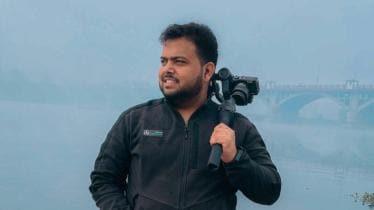Heritage storyteller and photographer Maroof Umar, better known as Maroof Culmen with a community of 5,20,000 followers (and growing) on Instagram, has almost become synonymous with the culture of Lucknow. In a conversation with Garima Sadhwani, he talks about his creative process, the language of aesthetics, and his love for Awadh. Edited excerpts:
Your content showcasing Awadh’s heritage is an inspiration to many folks on the internet, but what inspired you to start documenting these stories, monuments, and traditions?
Maroof: My inspiration stems from the childhood stories my mother used to tell me, weaving intricate tales of Lucknow’s history and culture. Those stories shaped my perspective and instilled in me a deep love for the city and its heritage. Awadh, with its unparalleled blend of Ganga-Jamuni tehzeeb, its architectural marvels, its food, and its people, feels like a living museum. The charm of capturing stories from this region lies in its unassuming beauty and its ability to keep surprising you. Every corner has a tale waiting to be told.
Your videos often show us the history and story behind the food, textiles, and monuments we’re so used to seeing around us. What’s the process of crafting these videos like? Does a lot of research go behind them?
Maroof: Absolutely. My process begins with deep dive research—reading books, visiting archives, and talking to local historians or custodians of these traditions. I make it a point to explore firsthand— whether it’s walking through old bylanes, sampling food in century-old shops, or spending time with artisans in their workshops. The idea is to let the story unfold naturally. It’s also a collaborative process with my team, who help me bring these narratives to life visually, ensuring that the details and emotions of the subject remain intact.
You’ve worked very closely with artisans and home cooks while telling their stories, and now with multiple celebrities as well. Tell us about that.
Maroof: The heart of my work lies in the stories of unsung heroes— artisans and home cooks who have quietly preserved heritage in their hands and hearts. Working with them has been humbling and enriching, as their authenticity brings depth to my narratives. Collaborating with celebrities brings a different dynamic; it helps amplify these voices and stories to a wider audience. It is essential to ensure that the work of our artisans and creatives is recognised and rewarded through partnerships that amplify their contributions.
The medium you work with is a fast-paced one, where there’s a new trend every other day. Does it then become challenging to sustainably tell the stories you want to?
Maroof: It is challenging but also empowering. While trends come and go, I’ve always chosen to remain true to my voice. The kind of storytelling I do is slow-paced, rooted in emotions and authenticity. Social media, despite its transient nature, offers a unique opportunity to connect with audiences who value depth over speed. For me, it’s not about chasing trends but creating timeless content that resonates with people.
Your Instagram feed is almost like a sensory overload of visual aesthetics. Tell us about your creative process?
Maroof: The process is very instinctive yet structured. It begins with immersing myself in the subject—understanding its essence, be it a monument, a dish, or a craft. The visuals are then designed to complement the story I want to tell. I draw inspiration from old photographs, poetry, and personal experiences to create a mood that aligns with the narrative. Every frame is intentional, capturing not just the subject but the emotions it evokes.
Your name is almost synonymous with Lucknow’s heritage storytelling now. What’s your favourite part about the city?
Maroof: It’s the people and their stories. Lucknow’s soul lies in its simplicity, its tehzeeb, and the pride its residents take in their heritage. I love the sense of timelessness here — sitting in an old café, listening to a qawwali, or just walking through the lanes of Chowk and Hazratganj. There’s a nostalgia in Lucknow that feels like home.
Would we be seeing more long-form content from you in the future—maybe a documentary or a feature film?
Maroof: Definitely. I’ve always wanted to explore the long-format space to delve deeper into the stories I love. There’s so much that can’t be captured in a minute-long reel. I’m already brainstorming concepts for documentaries and other formats to give these stories the space and depth they deserve.
Can you tell us about any future projects you’re pursuing at the moment?
Maroof: I’m working on a series that explores disappearing crafts and professions across India, delving into the lives of artisans and their struggles. Additionally, I’m planning to publish a book compiling some of my most cherished narratives.
The interview was conducted on the sidelines of ‘Journeying Across the Himalayas’, a 10-day festival held in New Delhi recently.
